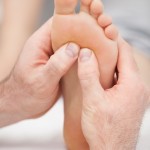The Painful Foot: Morton’s Neuroma

Back in high school I was a competitive sprinter. The front soles of my racing cleats were embedded with metal, pin-sharp spikes which sank into the track for extra traction and push off power. If you’ve never sprinted before, let me just say—the ball of your foot takes quite a beating!
At the end of my sophomore and junior seasons, I had raced well, placed in the counties and subsequently was moved up to the NY State finals. Unfortunately, I never got to run those races. You see, both years I had run so hard in my qualifying races that, as a result, I suffered a stress fracture in my right forefoot. Those teenage running injuries came back to haunt me in my forties in the form of a sharp, electrical-like forefoot pain caused merely by walking in the “wrong shoes.”
While you may not have received a traumatic injury to your own foot, you, too, may be experiencing a similar shooting pain in your forefoot, most commonly running between the 3rd and 4th long bones. Sometimes it can feel sharp, as though you were stepping on glass, and other times dull, like you have a flat rock in your shoe. If I’m describing something that’s been plaguing you, I have some information you’ll be interested in.
A common cause of forefoot pain and disability is a Morton’s neuroma. It’s a growth of scar/connective tissue which builds up around a nerve as it runs between the long bones in the foot. This condition develops in response to repetitive trauma (like the pounding of my running years) or from the squeezing your foot into tight or pointed shoes.
So, what’s the solution? The first thing to do is to wear shoes with a wider toe box. If need be, add a weight-distributing inner sole or gel pad to alleviate direct on the nerve. Additionally, avoid wearing high heels and do not squat for prolonged periods as both situations place undue pressure on the balls of your feet.
If none of the above eases your symptoms, you can be treated by a foot specialist (an orthopedist or podiatrist) who will likely inject the area with an anti-inflammatory medication. Surgery, to remove the fibrous tissue, is used as a last resort.